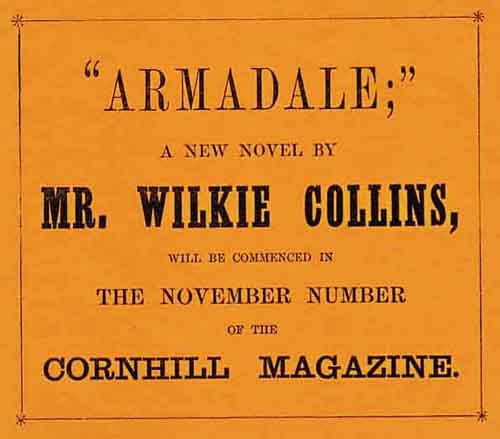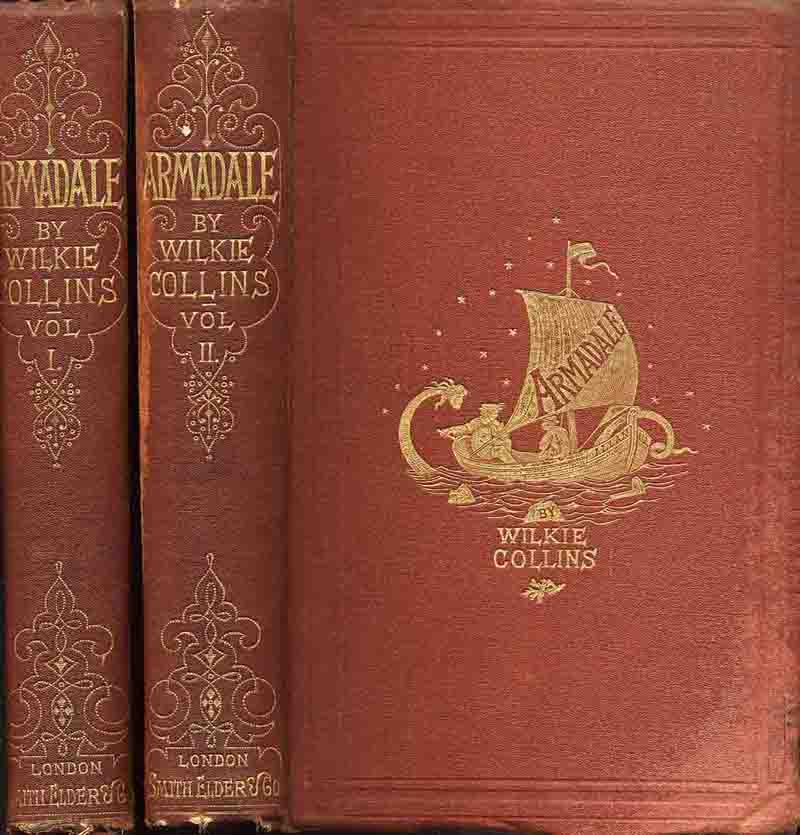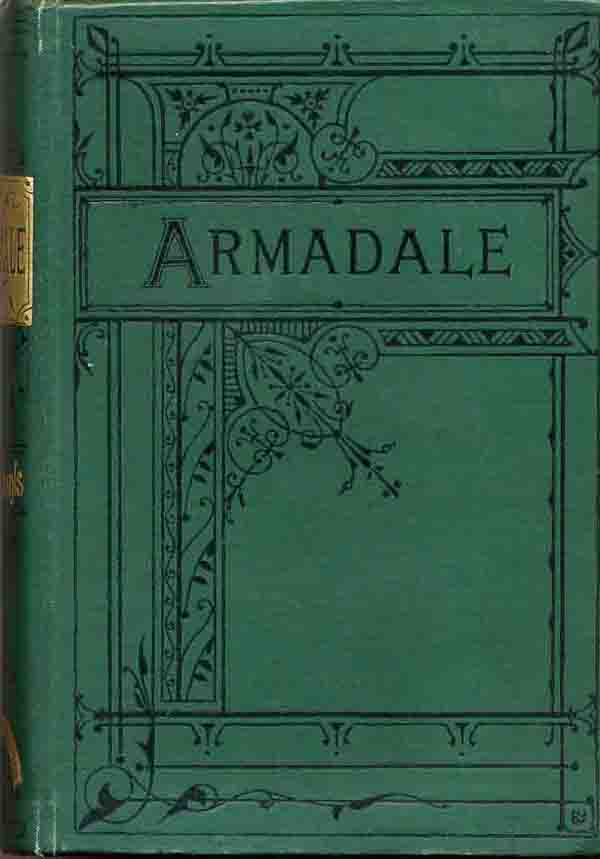'I was wondering...whether there is such a thing as chance'
[Plot Summary] [Publishing History] [Front Page]

Advertisement for Armadale
|
|
|
| 1866 first edition binding in two volumes by Smith, Elder. | Presentation copy to Lady Louisa Goldsmid, wife of Sir Francis Goldsmid, MP and noted Jewish philanthropist. |
Collins's longest novel, published in 1866 and dedicated to John Forster.
The story spans two generations of the Armadale families and the
complex plot combines several of Collins's favourite themes, including the
supernatural, identity, murder and detection.
A stage version of Armadale was published in 1866 to protect
dramatic copyright. Collins noted
in an Appendix that he had carefully researched certain aspects of the novel:
'Wherever the story touches on questions connected with Law, Medicine, or
Chemistry, it has been submitted, before publication, to the experience of
professional men.' The Ladies'
Toilette Repository of Mrs Oldershaw was based on the Bond Street beauty
parlour of the infamous Madame Rachel
Leverson, and Lydia Gwilt's criminal
past is partly drawn from the famous trial for murder of Madeleine Smith.
Collins wrote in the preface 'Viewed by the Clap-trap morality of the
day, this may be a very daring book. Judged
by the Christian morality which is of all time, it is simply a book daring
enough to speak the truth.' The
critics rose to the challenge. The
Spectator (9 June 1866) considered it 'a discordant mosaic instead of a
harmonious picture' and its heroine 'a woman fouler than the refuse of the
streets.' The Saturday Review
(16 June 1866) remarked on Collins's 'strange capacity for weaving
extraordinary plots. Armadale,
from beginning to end, is a lurid labyrinth of improbabilities.'
H. F. Chorley in The Athenaeum (2 June 1866) described the book
as 'a sensation novel with a vengeance', with 'one of the most hardened female
villains whose devices and desires have ever blackened fiction.'
In the twentieth century T. S. Eliot wrote 'The one of Collins's novels
which we should choose as the most typical, or as the best of the more
typical, and which we should recommend as a specimen of the melodramatic
fiction of the epoch, is Armadale.
It has no merit beyond melodrama, and it has every merit that melodrama
can have.' More recent critics,
however, have seen psychological depth and complexity as well as melodrama
|
|
|
| 1874 Smith, Elder yellowback | 1879 New edition by Smith, Elder |

In the Swiss town of Wildbad during 1832, Allan Armadale makes a deathbed
confession of murder, written down by the only other British visitor, Mr Neal.
The document is sent to Armadale's executors, to be given to his son
when he comes of age, warning him never to contact people connected with the
confession.
The dying man was born in Barbados and inherited the estate of his
godfather, his father's cousin, on condition he changed his name to that of
Allan Armadale, his godfather's disgraced natural son.
After receiving the inheritance, Armadale had fallen in love with the
portrait of Jane Blanchard, daughter of a family friend then staying in
Madeira. But before he could sail
to meet her, he was poisoned by his clerk, Fergus Ingleby.
By the time he reached Jane she had married Ingleby, deceiving her
father with a letter forged by her young maid.
Ingleby was really the disgraced Allan Armadale, marrying Jane in
revenge for the loss of his birthright. The
married couple escaped on a timber-ship, ironically called La Grace de Dieu,
but Armadale followed them disguised as a crew member.
The ship was partially wrecked during a hurricane and although Armadale
saved Jane, he locked her husband in a cabin, leaving him to drown.
Armadale departed for Trinidad where he married a half-cast woman who
named their son Allan. Just before
coming to Wildbad for his rapidly failing health, Armadale learned that Jane
also had an infant son called Allan Armadale.
The main story begins in 1851 when Jane's son, Allan Armadale, has by a
series of accidents inherited the Blanchard family estate at Thorpe Ambrose,
Norfolk. In the intervening years
he has been brought up in the west country by his reclusive mother and the
Reverend Decimus Brock who knows there is an undisclosed family secret.
Shortly after a visit by her former maid to extort money, Jane has died
leaving Brock to look after her son. Allan,
naive and immature, takes everything at face value and acts totally on
impulse.
Before he takes up his inheritance at Thorpe Ambrose, Allan arranges a
sailing trip with his only friend, the dark and mysterious Ozias Midwinter.
While cruising round the Isle of Man Midwinter, in reality the other
Allan Armadale, receives the letter written in Wildbad nineteen years earlier.
He shows the document to Brock, also on the trip, and reveals the story
of his earlier life. Midwinter had
been ill-treated after his mother married Mr Neal.
Escaping from school, he took up with a gipsy whose name he was happy
to borrow. When the gipsy died,
Midwinter continued the hard life of a vagabond, working as a servant, a
seaman, and an usher in a school. Dismissed
from this last post because of serious illness, he was rescued by Allan
Armadale, the first person ever to treat him with kindness.
Midwinter burns the letter, pledging to keep its secrets from Allan,
while Brock returns to Somerset now confident that Midwinter will protect his
friend. They borrow a boat from
the local doctor, Mr Hawbury, and become stranded on board the nearby wreck of
the old timber-ship, La Grace de Dieu.
Allan falls asleep and dreams of a drowning man, followed by three
other visions: the shadow of a woman by a pool at sunset; the shadow of a man
with a broken statue; and a man and woman passing him a glass, after which he
faints. Midwinter is convinced the
dream is supernatural while the doctor argues a rational explanation for all
of the predictions.

Allan, now 22, takes up residence at Thorpe Ambrose and innocently upsets
the entire neighbourhood as well as offending the family lawyer, Mr Darch.
To replace him Allan engages Mr Pedgift and his son who recommend the
elderly Mr Bashwood to teach Midwinter the duties of steward.
Bashwood is experienced in this role but lost his previous position
when bankrupted by a disreputable son, currently working as a private enquiry
agent. The steward's cottage is
occupied by Major Milroy, his bedridden wife and their daughter Eleanor (Neelie)
with whom Allan immediately falls in love.
Mrs Milroy is obsessively jealous of the governess and tricks Allan into
making enquiries about Miss Gwilt's references.
The resulting scandal puts him in an even worse light with his
neighbours and Pedgift resigns when Allan declines to take his advice.
Allan also quarrels with Midwinter and when a statuette is knocked over
the second vision of the dream is fulfilled.
Miss Gwilt realises there is no chance of marrying Allan and when
Midwinter reveals that his true name is also Allan Armadale she conceives a
new plot. She has fallen in love
with Midwinter, and if she marries him under his real name and can contrive
that Allan leaves Thorpe Ambrose and should somehow die, she can return as his
widow using the marriage certificate as evidence of her claim on the estate.
Allan goes to London to consult a new lawyer and Miss Gwilt arranges to
travel in the same railway compartment. They
are spotted by Bashwood, now so jealous that he employs his son to investigate
Miss Gwilt's background. They
learn that twenty-five years earlier she had been brought up by Mrs Oldershaw
before Jane Blanchard took her abroad as a maid.
To avoid further scandal after the death of Ingleby, the Blanchards
sent her to be educated in France where she took up with a Russian
card-sharper. She trapped a rich
Englishman called Waldron into marriage but poisoned him when she was
suspected of having an affair with a Cuban, Captain Manuel.
She was tried and convicted of murder but the case caused such a public
outcry that the sentence was quashed and she served just two years in prison
for theft. On release, the Cuban
married her bigamously but abandoned her after spending the money from
Waldron's will. She returned to
Mrs Oldershaw who ran a beauty parlour in association with the shady Dr
Downward.
Back in London, Miss Gwilt reconciles Midwinter and Allan and secretly
marries Midwinter. Needing Allan
to keep away from Thorpe Ambrose, she encourages him to see Brock in Somerset
and then to visit Naples where she will be living with her husband.
Two months later Allan arrives in Italy and one evening after the opera
faints when given a drink, so fulfilling the third vision from the dream.
Miss Gwilt is approached at the same time by Manuel who tries to
blackmail her for money. Instead
she arranges for him to captain Allan's new yacht, knowing that the Cuban will
rob and kill him.
Miss Gwilt returns to London and enlists the help of Dr Downward.
Under the alias Le Doux, he is opening a private sanatorium in
Hampstead where she pretends to be a patient in order to avoid Midwinter.
Miss Gwilt sees a newspaper report that Allan's yacht has been sunk and
writes to Thorpe Ambrose as his widow. She
once again makes use of Bashwood and he informs her that Allan has been
miraculously saved and is on his way back to England.
Late at night, under the pretext of seeing Miss Milroy, Bashwood lures
Allan and Midwinter to the sanatorium where the doctor offers them
accommodation. Downward has shown
Miss Gwilt the means of killing Allan by filling his room with a deadly gas
which leaves no trace; he will seem to have died from natural causes.
Midwinter senses that something is wrong and finding an excuse to
change rooms is overcome by the gas. Miss
Gwilt suddenly realises her mistake. She
still loves Midwinter and drags his unconscious body into the corridor.
When she is certain he will live, she writes a confession before
killing herself with the poison.
Midwinter allows the world to think Miss Gwilt died naturally while
Bashwood loses his reason. Allan
marries Miss Milroy leaving Midwinter convinced the visions were in fact meant
to bring the two Armadales closer together.
|
|
|
| 1879 Smith, Elder new edition in limp cloth | 1895 Chatto & Windus new edition in limp cloth |
Serialisation
Cornhill, November
1864--June 1866; Harper's New Monthly Magazine, December 1864--July 1866.
Book Publication
First English edition
2 volumes, Smith, Elder, London 1866.
Red-brown cloth, front covers blocked in gilt and blind, spines lettered
in gilt, pale yellow end-papers. No
half-titles. Twenty illustrations by
George H. Thomas, nine in volume 1 and eleven in volume 2.
Published in June 1866 (advertised as for sale on 18 May).
Vol I
(viii) + 304 pp
Vol II
(iv) + 372 pp
Second and third editions, 2 vols, 1866.
1 volume editions
Smith, Elder 1867-1890; Chatto & Windus 1891-1920; Dover, New York
1977; World's Classics 1989 (critical edition, edited by C. Peters); Folio
Society 1992.
1st US edition
Harper's, New York 1866 (advertised as for sale on 26 May)
Translations
German, Leipzig 1866, 1878; Russian, St Petersburg 1871; Dutch, The Hague
1866, 1875.
[Top of Page] [Back to Main Works] [Front Page]





